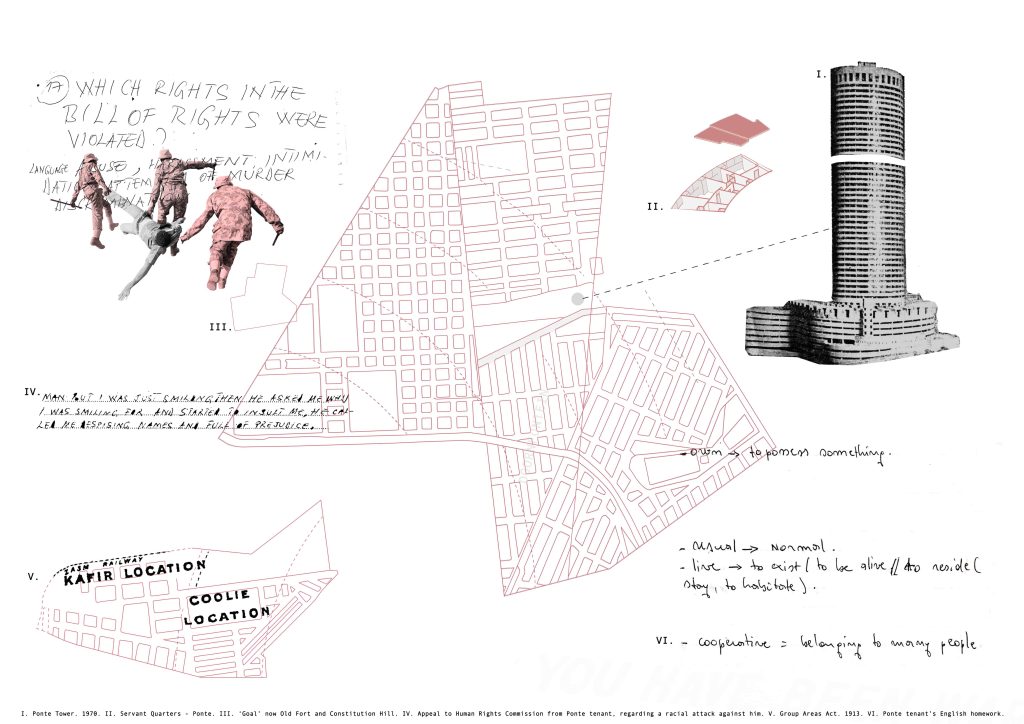
Denise Lim, Mellon Postdoctoral Fellow in Black Material and Visual Culture, Wins National Endowment for the Humanities Fellowship
Built in 1975 as an urban space for white privilege, luxury, and global aspirations, Ponte City is a 54-story apartment building in Johannesburg that is now both an iconic, Brutalist-style landmark and vibrant home for a diverse community in South Africa.
For Denise Lim, a Mellon Postdoctoral Research Fellow in Black Material and Visual Culture in the School of Art and Design History and Theory at Parsons, Ponte is the basis of her ambitious research project. Recently awarded a National Endowment for the Humanities (NEH) Fellowship for Digital Publication, Excavating Palimpsests in Ponte City is an interactive website based upon six years of doctoral research and will explore the social history, architectural design, and material or visual cultures of Ponte during and after apartheid.
After first learning about the famous building in 2014, Lim has since gone on to live in Johannesburg, where she visited Ponte to conduct interviews with residents, staff members, and the site’s official tour operator Dlala Nje. She also took photographs of the building, cataloged found objects left behind by past tenants, and digitized historical records from the National Archives to unearth the community’s unique stories.
“The inspiration for this digital project really came from the fact that all the archival evidence or data I collected on the building could not be adequately appreciated in writing alone,” explains Lim. “I wanted others to be able to see it, hear it, and feel it. What I found striking was that the more ‘digging’ I did, the more I would find something that truly surprised me. No matter how many news articles I read about Ponte, nothing could quite replace the experience of being able to physically visit the building myself, walk through its hallways, or peer up at the hollow core of the building.”

Lim’s experience in the transdisciplinary research of diverse African communities spans more than 17 years, beginning with her semester abroad studying at the University of Cape Town while an undergraduate student. As she was finishing her M.A. in African Studies and getting ready to pursue her Ph.D. in Sociology at Yale, she began to develop an interest in modern and contemporary South African art. This eventually led her to meet South African artist Mikhael Subotzky and British artist Patrick Waterhouse to catalog, scan, and study over 800 artifacts collected for their Ponte City (2014) art exhibition and photo book.
“While I always had an interest in South African art and culture, I never would have predicted that my interests would turn towards place-based research or urban politics until I moved to Johannesburg to commence my dissertation fieldwork,” shares Lim. “In the South African context, no one can escape the austerity of colonial and apartheid legacies. But I began to take seriously the power that place-based research wields in art and design and the transformative impact it can have for marginalized people of color. It matters what, when, and where we choose to study, because these sites reveal histories, futures, and politics that can both illuminate local nuances and achieve global resonance.”
In order to bring her project to completion, Lim will collaborate with South African architects Zakiyyah Haffejee and Adam Osman of brickstreet studio, who are assisting in the design of her Ponte website. It is of great importance to Lim that South Africans are supported in the project, as she wants the publication to resonate most with the diverse communities for whom Ponte holds great meaning.


L-R: Architectural sketch of the Hillbrow and Berea neighborhoods in Johannesburg, with overlays of handwritten notes drawn from archival bureaucratic documents by past Ponte City residents and iconic archival imagery of police brutality during apartheid. Illustration by Tarika Pather. Courtesy of Counterspace Studio.
Speculative drawing of abandoned Ponte flat 3607 based upon a photograph reprinted in “Booklet VII – Afterimages” in Mikhael Subotzky and Patrick Waterhouse’s Ponte City (2014) with isolated found objects. Illustration by Sarah de Villiers and Tarika Pather. Courtesy of Counterspace Studio.
“Traditional academic monographs or peer-reviewed articles are rarely read outside an academic elite,” says Lim. “Though there are great divides in technological access and education in South Africa, different versions of the website will be adapted to fit the technological specifications of different devices and the needs of users with limited economic means. I’ll also be hiring interpreters to translate all content into indigenous South African languages commonly spoken in Johannesburg such as isiZulu, seSotho, seTswana, and other European languages spoken by African foreign nationals in the inner-city such as French and Portuguese. Users will be given the option to not only select the language they read or hear on the website, but there will be accessibility options for those who may be hearing or seeing impaired. This grant plays an important role in elevating how scholars design and disseminate their scholarship, and I’m grateful to have this opportunity.”
The final digital project will be an important resource for students, scholars, and practitioners working in art and design, museum studies, African urban studies, architecture, and more. For Lim, the project has come to define her research portfolio, where she regularly aims to challenge conventions that are implicit in ethnocentric ideologies from the global North.
“I hope this website demonstrates how remnants of these different events and experiences from multiple time periods exist all at once as a cultural palimpsest,” explains Lim. “As the user chooses what layers to ‘peel back’ on the website, I hope that they find there are artifacts that will challenge their own stereotypes or assumptions about Ponte’s spatial politics and yield deeper understanding and compassion for the structural reasons for its existence.”
Lim is currently one of eight postdoctoral fellows in the Mellon Initiative, a program designed to provide intellectual community, support, and mentorship to scholars of color. She will begin teaching as an assistant professor in the fall 2024 semester, which she finds to be a highlight of her job as a scholar and educator. Lim is eager to introduce new topics and areas of practice to students.
“As African Studies is often underrepresented at the college and university-level, I work hard to offer courses that introduce students to a broad range of themes, cultural contexts, and artistic practices,” Lim shares. “I treat the classroom as a space where we can safely experiment, innovate, and create new mediums for scholarship.”
Lim has also been busy with other projects, including an article she co-authored in May 2023 that was published in the Asian Diasporic Visual Cultures journal called “Architecting Friendship: A Spatial Commemoration of Yuri Kochiyama and El-Hajj Malik El-Shabazz/Malcolm X.” She is currently revising the article for a chapter in a forthcoming anthology, Mapping Malcolm, edited by Najha Zigbi-Johnson for Columbia Books on Architecture and the City.